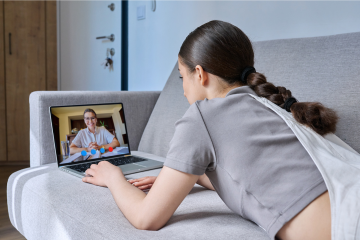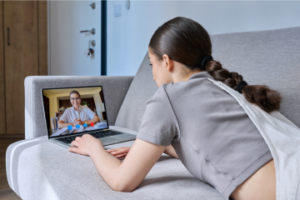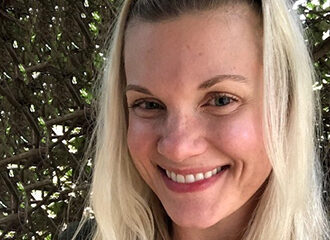Written By: Adrienne Kerrigan, M.ED, PCC and Laura McLain, PsyD, BC-TMH
Virtual Intensive Outpatient Program (IOP) offers comprehensive care that blends the structure of in-person treatment with the convenience of accessing therapy from home. Whether you’re balancing work, school, or caregiving responsibilities, Virtual IOP can provide the same kind of treatment and therapeutic support as an in-person program, helping you stay connected to your recovery without disrupting your daily life. In this post, we explore what to expect from this type of program.
What is an Intensive Outpatient Program (IOP)?
An Intensive Outpatient Program (IOP) is a type of treatment that provides additional support in recovery while remaining connected to everyday life. Individuals who attend IOP programs are often students, employees, volunteers, and/or primary caregivers. Our IOP programs are three evenings per week for 3 hours each day. Patients attend groups, join meal support, and meet with their treatment team for individual, family/support, and nutrition sessions.
Understanding Virtual IOP Treatment
IOP in Eating Disorder Treatment
For someone actively recovering from an eating disorder, an IOP program can be a fantastic addition to their support team. It provides an opportunity to receive structured and intensive group and meal support and connect with others with similar experiences while remaining connected to their everyday obligations. A virtual IOP program is great option for individuals who are not able to attend an in-person IOP program or who don’t have many eating disorder resources in their area. The IOP treatment team will collaborate with the individual’s outpatient team to ensure that they have the best support on their recovery journey.
Differences and Benefits of Virtual IOP
There are some differences and similarities between an in-person and virtual IOP program. Both programs typically follow a similar group and meal structure, use the same treatment model, and offer specialized groups based on client needs. The major difference with a virtual program is that individuals are in their own homes, in a private and confidential space, joining on their laptop or tablet. While virtual programs can feel unusual at first, especially for those who have previously experienced in-person treatment, it typically doesn’t take individuals long to make lasting connections with their peers and staff.
Initial Assessment and Onboarding
What to Expect During the Assessment
After the individual calls to inquire about virtual IOP, they are scheduled with a Clinical Assessor for a virtual assessment. During the assessment, which can last 1-2 hours, the Clinical Assessor gathers information about their eating disorder, mental health history, social and family history, and cultural history. The individual also identifies treatment goals related to their eating disorder, mental health, and support system to focus on in treatment. Once the individual completes the assessment and is cleared to start the program, the virtual IOP admissions team will establish a start date.
Your First Week of Virtual IOP
On the first day of treatment, everyone completes a virtual orientation which reviews the structure and philosophy of the program, logistics, and expectations for participation. Individuals must have wi-fi, a device with audio/video capabilities (such as a cell phone or laptop computer), and a private space to preserve confidentiality. Clients are provided a secure log-in to join virtual, HIPAA- compliant sessions from their private confidential space.
During their first week in virtual IOP, individuals will attend group therapy sessions that focus on emotional awareness and tolerance, body image, relationships, values, and nutrition. They will attend staff-lead meal support groups to help identify their emotions within the context of the meal. Additionally, individuals with meet with their individual and family therapist, dietitian, and psychiatric provider (if needed).
Treatment Structure of Virtual IOP
The virtual IOP program is designed to address various factors that maintain the eating disorder and provide education and tools to help individuals decrease their eating disorder symptoms. Each day of program an individual will attend two therapeutic groups and one meal support group with their peers. The therapeutic groups focus on building emotional awareness and distress tolerance, increasing cognitive flexibility, identifying values and goals, assessing motivation, and understanding the role of body image. While everyone’s recovery journey is different, most individuals attend virtual IOP about 8-12 weeks.
Individual therapy sessions focus on identifying and assessing treatment goals, understanding how emotions and thinking patterns impact the eating disorder, challenging negative body image thoughts, improving awareness of body cues, and building tolerance to emotional experiences. Nutrition sessions include identifying each person’s nutritional needs and goals, establishing a meal plan to help achieve adequate nutrition, choosing food challenges, tracking patterns related to eating disorder behaviors, and increasing comfort with meal planning and social eating. Family and support sessions offer education about the eating disorder and teach supports how to provide emotional and practical support in recovery, communicate effectively, and strengthen connection.
Key Components of Virtual Outpatient Treatment
All programs within Renfrew use the Renfrew Center’s Unified Treatment Model for Eating Disorders. It is an evidence-based treatment that targets the underlying factors that reinforce the eating disorder symptoms and other emotional avoidance strategies. During treatment, individuals will observe their emotional experiences, identify the emotions that are difficult to feel, and learn how to take risks in their recovery. Some examples of the therapeutic tools used in treatment include:
- Mindfulness – The concept of mindfulness is embedded throughout the treatment program. It involves paying attention to the present moment without judgment
- 3-Components of an Emotion – This foundational tool is used to break down overwhelming emotions into separate parts (i.e., thoughts, physical sensations, and behaviors/urges)
- The ARC of an Emotional Experience – This tool provides a snapshot of an emotional experience from start to finish. It reveals the triggers of emotional experiences (i.e., antecedents), the emotional responses in that situation (e thoughts, sensations, urges, and behaviors), and the outcomes of that response (both short and long-term consequences).
- Appraisals and Core Beliefs – It’s helpful to understand the role of our automatic thoughts (appraisals) because they directly influence our emotional experiences and eating disorder behaviors. Improving awareness of our core beliefs reveals the source of our interpretations and often reveals when someone still needs to work on thinking more flexibly.
Another essential component of treatment involves identifying a strong support system. While this supportive network may include parents or family members for some, that may not be appropriate for everyone. Some individuals include their partners, close friends, spiritual leaders, or colleagues in their journey A support person is someone who helps an individual feel less alone in their struggle, learns the tools needed to navigate tricky situations, and works towards increasing connection and understanding.
Interaction with Treatment Team
One of the main differences between in-person treatment and virtual IOP is the communication with your treatment team. Virtual providers will primarily use email to schedule sessions and send links for virtual sessions. Phone calls are also used frequently in the virtual space to check in with individuals for clinical reasons. However, video sessions are the preferred method of communication for any clinical matters. Individuals who need to reach their treatment team can do so via email or phone call while programming.
Challenges of Virtual IOP & How to Overcome Them
While virtual IOP is very exciting and convenient in many ways, there are some challenges specific to this form of treatment. The most common are screen fatigue, lack of physical presence in the virtual space, and difficulties seeing one’s body on screen. To address screen fatigue, all individuals in the virtual space are encouraged to take screen breaks between groups and meals.
Treatment staff will typically encourage individuals to stretch before group starts if they are noticing lower energy. Some individuals struggle to log in and attend consistently because of screen fatigue or other distractions. To make the most out of treatment, individuals are often encourages to openly express their concerns and discuss options with their treatment team. Finally, some individuals are uncomfortable seeing their image on screen during groups and sessions. If this is a concern as you’re setting into treatment, there are features in the video settings to hide your image.
Transitioning Out of Virtual IOP
Signs Someone is Ready to Return to OP
The goal for everyone is to return to their OP team with tools and strategies to sustain long-term eating disorder recovery. Some of the indicators someone is ready to discharge virtual IOP include:
- Significant reduction or elimination of eating disorder symptoms
- Increased awareness and tolerance of uncomfortable emotions
- Ability to identify thinking traps and think more flexibly Reduced body image distress and/or increased body tolerance
- Willingness to take risks and lean into emotional discomfort
- An increase in mindfulness and being in the present
- Better ability to identify needs and ask for support when needed
- Significant reduction and/or absence of safety concerns
Planning for Continued Support and Aftercare
Our goal for anyone who attends treatment is to return to their OP team or to provide referrals for individuals who have yet to establish an eating disorder team. Additional services that can be helpful when you return to outpatient providers are meal support groups or outpatient support groups. Having a trusted peer, family member, and/or partner is also helpful for most individuals.
Conclusion
We hope this information is helpful for those who might be considering virtual IOP eating disorder treatment. We know this process can be overwhelming at times and there are many steps in this process. Please know that we are here to support you however we can while you are on your recovery journey.
If you or someone you know is struggling, we would like you to know that recovery is possible. For more information on The Renfrew Center’s virtual IOP program, you can call 1-800-Renfrew or visit us online at www.renfrewcenter.com.




